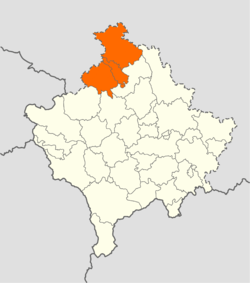Leposavić
| Leposavić | ||
|---|---|---|
| Municipality and city | ||
| Albanian: Leposaviq Serbian: Лепосавић (Leposavić) Turkish: Leposaviç | ||
|
Church of St. Basil of Ostrog | ||
| ||
 Leposavić Location in Kosovo | ||
| Coordinates: 43°06′N 20°48′E / 43.100°N 20.800°ECoordinates: 43°06′N 20°48′E / 43.100°N 20.800°E | ||
| Country | Kosovo[lower-alpha 1] | |
| District | District of Mitrovica | |
| Government | ||
| • Mayor | Branko Ninić | |
| Area | ||
| • Land | 539 km2 (208 sq mi) | |
| Population | ||
| • Total | 20,000 (municipality) | |
| • Density | 120/km2 (300/sq mi) | |
| As of 2007[1] | ||
| Time zone | CET (UTC+1) | |
| • Summer (DST) | CEST (UTC+2) | |
| Area code(s) | +381 | |
| Car plates | 02 | |
| Website | Leposavić | |
Leposavić (pronounced [lɛ̌pɔsaʋitɕ], Serbian: Лепосавић, Albanian: Leposaviq, Turkish: Leposaviç) is a town and the northernmost municipality in the District of Mitrovica of northern Kosovo. It is a part of North Kosovo, a region populated with at least 98% ethnic Serbs that functions largely autonomously from the remainder of Kosovo, which is majority ethnic Albanian. According to OSCE and UNHCR estimates, the municipality has a population of approximately 18,600 (2007).[1] The municipality consists of a town and 72 villages with an area of 539 km².
Settlements
Bare · Belo Brdo · Beluće · Berberište · Bistrica · Borova · Borčane · Brzance · Vitanoviće · Vračevo · Vuča · Gnježdane · Gornji Krnjin · Graničane · Grkaje · Guvnište · Gulije · Desetak · Dobrava · Donje Isevo · Donji Krnjin · Dren · Duboka · Zabrđe · Zavrata · Zemanica · Zrnosek · Ibarsko Postenje · Jarinje · Jelakce · Jošanica · Kajkovo · Kamenica · Kijevčiće · Koporiće · Kostin Potok · Košutica · Košutovo · Kruševo · Kruščica · Kutnje · Lazine · Leposavić · Lešak · Lozno · Majdevo · Mekiniće · Miokoviće · Mioliće · Mošnica · Ostraće · Plakaonica · Planinica · Popovce · Potkomlje · Pridvorica · Rvatska · Rodelj · Rucmance · Seoce · Slatina · Sočanica · Tvrđan · Trebiće · Trikose · Ćirkoviće · Ulije · Ceranja · Crveni · Crnatovo · Šaljska Bistrica
History
Lešak, Belo Brdo, Vračevo, Berberište were added to the Autonomous District of Kosovo and Metohija in 1953; these are part of Leposavić.
Economy
Almost all industrial facilities are closed or work with reduced capacity. The unemployment rate is also high, and it has been considerably increased due to the closing down of most of the Trepča conglomerate facilities. The municipality is rich in natural, infrastructure and management, but current circumstances blocked all the potentials. The municipality adopted the Development Agenda 2006 – 2009, in cooperation with UNOPS and with the support of UNMIK and the Italian Government, which foresees improvement in the local economy. Given the current difficult situation,however, there is not much hope the Agenda will be properly implemented. The municipality, led by a very proactive CEO, pays noteworthy efforts toward identifying and initiating projects ideas.[1]
Demographics
Leposavić municipality includes 72 villages with a total of 18,600 inhabitants, according to the UNHCR and OSCE estimates. Ethnic Serbs constitute the supermajority (18,000), while small numbers of other communities are also present. Approximately 200 Kosovo Albanians live in the three southern villages of Košutovo, Šaljska Bistrica, and Ceranje. There are also 240 Kosovo Bosniaks, Romas, Ashkalis, and Egyptians.
| Ethnic composition, including IDPs | |||||||||||||
| Year/Population | Albanians | % | Serbs | % | Muslims/Bosniaks | % | Roma | % | Total | ||||
|---|---|---|---|---|---|---|---|---|---|---|---|---|---|
| 19911 | 1,101 | 6.7 | 14,306 | 87.8 | 600 | 3.7 | 163 | 1.0 | 16,291 | ||||
| January 19992 | 902 | N/A | 15,365 | N/A | 940 | N/A | N/A | N/A | N/A | ||||
| October 20073 | 280 | 1% | 18,000 | 97% | 420 | 1% | 2504 | 1% | 20,600 | ||||
| |||||||||||||
According to the 1991 census, the municipality of Leposavić had a population of 16,395 people.
See also
Annotations
- ↑ Kosovo is the subject of a territorial dispute between the Republic of Serbia and the Republic of Kosovo. The latter declared independence on 17 February 2008, but Serbia continues to claim it as part of its own sovereign territory. Kosovo's independence has been recognised by 108 out of 193 United Nations member states.
References
- ↑ 1.0 1.1 1.2 OSCE Municipal profile of Leposavić PDF, October 2007. Retrieved on 9 March 2008.
External links
| ||||||||
| Wikimedia Commons has media related to Leposavić. |
| ||||||||||||||||||||||||||||||||



